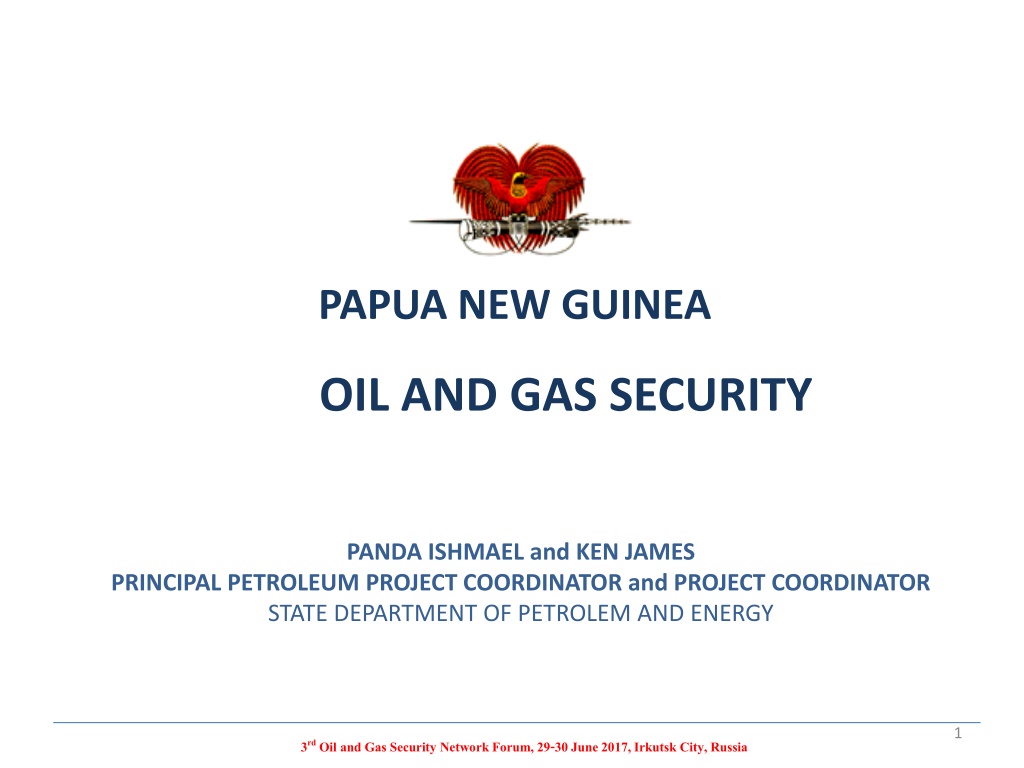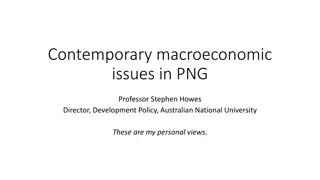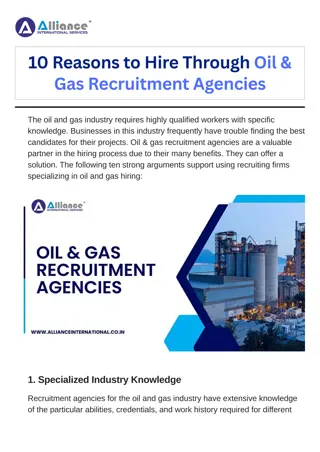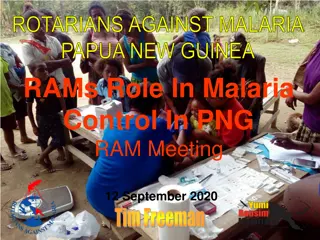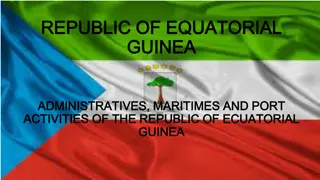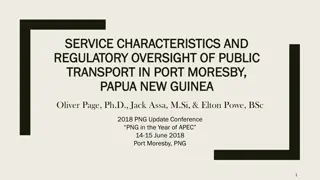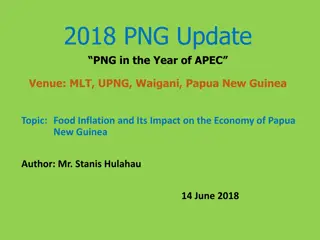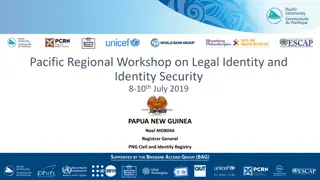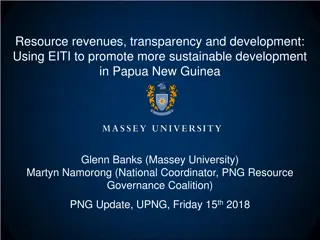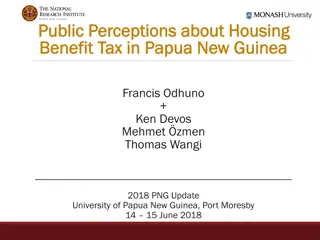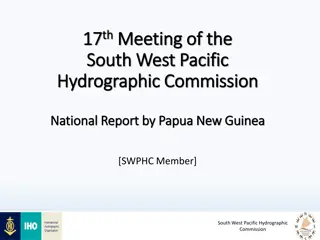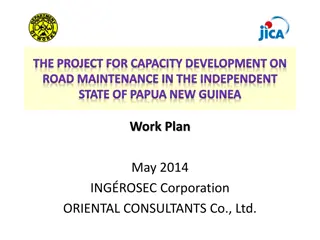Papua New Guinea Oil and Gas Industry Overview
Papua New Guinea (PNG) is a significant player in the oil and gas industry, with production of crude oil and LNG. The country's oil production began in 1991, while LNG production commenced in 2014. PNG has refining capabilities and both exports and imports petroleum products. The country has notable oil reserves and is exploring gas fields for future projects. LNG production and export, along with discussions for gas supply for power generation, are key focus areas for the industry in PNG.
Download Presentation

Please find below an Image/Link to download the presentation.
The content on the website is provided AS IS for your information and personal use only. It may not be sold, licensed, or shared on other websites without obtaining consent from the author. Download presentation by click this link. If you encounter any issues during the download, it is possible that the publisher has removed the file from their server.
E N D
Presentation Transcript
PAPUA NEW GUINEA OIL AND GAS SECURITY PANDA ISHMAEL and KEN JAMES PRINCIPAL PETROLEUM PROJECT COORDINATOR and PROJECT COORDINATOR STATE DEPARTMENT OF PETROLEM AND ENERGY 1 3rd Oil and Gas Security Network Forum, 29-30 June 2017, Irkutsk City, Russia
PAPUA NEW GUINEA Oil and Gas Supply and Demand Situation Introduction o Papua New Guinea (PNG) produces and Exports mainly oil until recently started producing LNG and exported o Crude Oil production in PNG began in 1991 by Chevron until Oil Search took over in 2004 o LNG production and export started in 2014 by Exxon Mobil. o PNG has only 1 refinery. Napanapa Refinery built and operated by InterOil and recently bought by Puma Energy o 2 Mini Refineries are operated by Oil Search and petroleum products used for internal operations only. 2 3rd Oil and Gas Security Network Forum, 29-30 June 2017, Irkutsk City, Russia
PAPUA NEW GUINEA Oil and Gas Supply and Demand Situation Crude Oil Supply and Demand in PNG o Cumulative Crude Oil production in PNG since production began in 1991 is 49, 980, 872 stbo o However, Oil production from the maturing fields are declining at rate of approx. 11% (latest 2016, Oil Search) o Current producing fields produce Sweet Crude and Condensate. o Most of the crude were exported until 2004 when the (Napanapa) in PNG was completed, thus local supply began. o Oil/Condensate approximately 2 billion Kina per year (USD 700 Million equivalent) only refinery exports generates 3 3rd Oil and Gas Security Network Forum, 29-30 June 2017, Irkutsk City, Russia
PAPUA NEW GUINEA Oil and Gas Supply and Demand Situation Crude Oil Supply and Demand in PNG o Refinery (Napanapa) also imports crude oil from Australia, Malaysia and Africa to meet refinery requirements, which supplies 70% of the local petroleum product needs. o The remaining 30% of petroleum product need in PNG is imported and supplied by other agents (Island Mobil, Total, Niugini Oil, etc) o PNG s Oil Reserves stands at approximately; o Maturing fields (Oil Search Operated) 59, 427 Mstbo (2P Reserves) o Considerable condensate have been discovered in most gas fields like the PNG LNG project and in most exploration licenses. That includes proposed LNG project fields; 1. Papua LNG (Total Operated) Elk/Antelope; (approx. 9 tcf gas) 2. P nyang Fields (Exxon & Oil Search) (2.5 tcf gas) 3. Western LNG (Repsol & Horizon) Ketu/Elevala; Stanley Gas; etc, (approx. 4 tcf) 4 3rd Oil and Gas Security Network Forum, 29-30 June 2017, Irkutsk City, Russia
PAPUA NEW GUINEA Oil and Gas Supply and Demand Situation Gas Supply and Demand in PNG o LNG production and export in PNG is first-hand (2014) o Cumulative LNG Production in PNG since LNG production began in 2014 to end 2016 is 745,844.19 mmscf of which 29,122,467 m3 exported o However, Gas has been produced in Hides and supplied to Pogera Gold Mine for Power generation since 1991. On average, 425.66 produce 2 MW/month. o GoPNG and Exxon Mobil are currently discussion options to supply gas for power generation with in PNG. o Import of LPG (liquid petroleum gas) is steadily increasing at 5% rate. It is only consumed by 3% of the population. o LPG is imported from Australia by Origin Gas. PNG LNG gas export figures Gas Production Historical Data Gas Export Historical Data Year Hides Gas Production (mmscf) 169,031.00 341,475.19 235,338.00 LNG Export (m3) 2014 2015 2016 TOTAL 6,932,790 9,522,199 12,667,478 29,122,467 mmscf/month to 745,844 5 3rd Oil and Gas Security Network Forum, 29-30 June 2017, Irkutsk City, Russia
PAPUA NEW GUINEA Oil and Gas Supply and Demand Situation Gas Supply and Demand in PNG o PNG LNG exported 29, 122, 467 m3 of LNG to Asian Markets since 2014. It is the single largest export commodity in PNG. o PNG LNG shipped mostly to buyers in Japan, China and Taiwan. In 2016 project operated well-above its design capacity of 9.4bcm, and a utilisation rate of 113.0% o LNG exports generate approximately 10 billion kina per year (USD 3 billion equivalent) o Current PNG gas reserve stands at approximately 30 tcf. (this is from both producing and exploration fields, thus some have not been certified by third party) 6 3rd Oil and Gas Security Network Forum, 29-30 June 2017, Irkutsk City, Russia
PAPUA NEW GUINEA Oil and Gas Supply and Demand Situation Refinery Capacity and Oil productions in PNG o The Napanapa Refinery has a full capacity of 36,000 bpd o Refinery blends sweet crude from Kutubu (PNG) with imported crude oil from Australia, Malaysia and Africa to meet refinery requirements, o 65 % of the Petroleum products from the refinery is supplied to meet 70% of the local petroleum product needs. The remaining 35% is exported to Asian markets. o The remaining 30% of petroleum product need in PNG is imported and distributed by other agents (Island Mobil, Total, Niugini Oil, etc) o The refinery has a capacity to store 750,000 barrels of crude and approximately 1.1 million barrels of refined products. 7 3rd Oil and Gas Security Network Forum, 29-30 June 2017, Irkutsk City, Russia
PAPUA NEW GUINEA Oil and Gas Supply and Demand Situation Natural Gas Production and Consumption in PNG o PNG LNG project is primarily for export and there is no domestic offtake of gas. o The use of gas to generate electricity is yet another environmentally clean option to meet future demand o However, there is no clear policy for the gas sector, which will impede the use of gas for power generation. o A framework for development of gas- based power generation is also planned and is negotiated by GoPNG with companies. o LPG (Liquid Petroleum Gas) is the only gas imported. The refinery also produces and supplies to domestic market. attractive and Source: Government of Papua New Guinea, Department of National Planning and Monitoring. 2010. Papua New Guinea Development Strategic Plan, 2010 2030. Port Moresby. o Gas will be a major play in power generation in PNG in the near future as per GoPNG plan 8 3rd Oil and Gas Security Network Forum, 29-30 June 2017, Irkutsk City, Russia
PAPUA NEW GUINEA Oil and Gas Supply and Demand Situation Natural Gas Production and Export o PNG primarily exports LNG gas. Approximately 6.6 million tones per year. Produced and transported 700km from the highlands to the loading point near Port Moresby. o 4 major customer; o 1. Chinese Petroleum Corporation of Taiwan (1.2 Mtpa) o 2. Osaka Gas Company (1.5 Mtpa) o 3. Tokyo Electric Power Company of Japan (1.8 Mtpa) o 4. Unipec Asia Company (2 Mpta) (a subsidiary of Sinopec) 9 3rd Oil and Gas Security Network Forum, 29-30 June 2017, Irkutsk City, Russia
PAPUA NEW GUINEA Oil and Gas Security Policy Oil & Gas Supply Security Policy o The country wishes to build from oil production and develop gas, but while the country has an oil and gas act, it has no gas or petroleum policy at present. Contracts are negotiated and regulatory conditions are mandated through contracts (Gas Agreements/MOA) rather than through a transparent policy. The existing liquefied natural gas (LNG) project is exporting all its output and is not available for domestic market obligations in the country. o The country still lacks a comprehensive energy sector policy. A draft policy has been prepared and is under consideration, and the Department of Petroleum & Energy (DPE) expects that the policy will be finalized and adopted. o The country wishes to develop gas based power generation but lacks policy. o Thus, there are no indicators in place to gauge security of supply. o PNG does not have tragic oil stock holding facilities for emergency oil and gas supply disruptions except existing companies storage facilities. 10 3rd Oil and Gas Security Network Forum, 29-30 June 2017, Irkutsk City, Russia
PAPUA NEW GUINEA Oil and Gas Security Policy Gaps Policy Issues and Gaps that need to be addressed o There is no clear policy for the gas sector, which will impede the use of gas for power generation and/or local domestic market obligations. o There are constraints in the formulation of the draft policy. Lack of capacity Lack of capacity in terms of human and physical resources Management Support and Commitment Lacking management formulation of key policies Training & Capacity Building support and attention towards o Institutional capacity is also a constraint. The DPE has inadequate trained staff to undertake all its intended functions and plans. 11 3rd Oil and Gas Security Network Forum, 29-30 June 2017, Irkutsk City, Russia
Thank you Email Address: panda_ishmael@yahoo.com Contact Number: 675 71603874 Ken.jamesolpes@gmail.com 12 3rd Oil and Gas Security Network Forum, 29-30 June 2017, Irkutsk City, Russia
